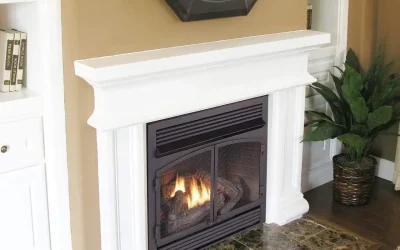The weather begins to cool, and homes are filled with pumpkin spice and apple cider scents. Many people are preparing for winter by lighting their fireplaces. But before you light that first fire of the season, it’s important to inspect the fireplace for damage.
While a fireplace can be a cozy addition to any home, inspecting it for safety before use is important. The National Fire Protection Association (NFPA) says that more than 9,000 fires start in chimneys or flues each year, many of which are caused by creosote build-up.
This article will introduce how to inspect the fireplace for safety, including tips on identifying common hazards.
Necessary Tools for Inspecting A Fireplace
When inspecting your fireplace, it is important to have the necessary tools.
- You will need a flashlight to help see into the crevices of the fireplace,
- A mirror to help look for cracks in the flue
- A small camera or mobile phone can also be helpful in getting a closer look at any damage that may have occurred.
- A chimney brush to clean out any built-up creosote.
- And a vacuum cleaner. For the vacuum cleaner you can check on this article about the best ash vacuum to buy.
How to Inspect a Fireplace Before Use
Start with checking the fire glass
Before you light a fire in your fireplace this winter, take a few minutes to check the glass. Cracks or other damage could result in sparks flying out and starting a fire in your home. Also, clean the glass for a better view of the fire.
Check the fireplace screen
The fireplace screen is one of the most important parts of your fireplace. A fireplace screen protects you from flying embers and sparks. It also keeps children and pets safe from the dangerous flames.
A broken or damaged fireplace screen can be a serious hazard. It could cause a fire in your home or, even worse, serious injuries.
That’s why it’s so important to check your fireplace screen regularly. Look for cracks and any visible damages. You can use a flashlight for that. If there are any cracks, they will reflect in the light.
Make sure there are no cracks or holes in the screen. If there are, repair them or better replace them as soon as possible.
Check the hearth and floor
Before you light that first fire of the season, It’s important to check the hearth and floor of your fireplace for any damage that could lead to a dangerous fire. Keep the hearth clear of debris and the floor in good condition.
If you have a brick or stone fireplace, check for cracks in the masonry. Make sure the mortar is in good condition and isn’t crumbling.
The floor of your fireplace should be even and stable. If it’s not, and you notice some crack that you may need to repair. Use a concrete mixer or puttings to heal the cracks.
A replacement will be the best option if the floor has major damage. Use non-combustible materials on the floor of your fireplaces, such as tile or metal.
Inspecting the firebox
When inspecting the firebox of a fireplace, you need to consider several things. Check for corrosion on the metal parts of the fireplace. If it is severe, the parts may need to be replaced. Also, check if the log grate is in well-to-do condition.
Look for creosote build-up
Creosote is a black or brown tarry substance produced when wood or other organic matter burns. It can build up in chimneys and fireplaces and cause several problems, including a dangerous fire hazard.
The best practice is to clean your fireplace with a damp cloth after every use. That will restrain you from heavy cleaning at a time.
However, look for signs of creosote build-up inside and out during the inspection. If there is any, clean following proper steps and process. Here is a guide for cleaning a fireplace that might help you.
Keep the damper clean
The damper is the part of the chimney that regulates airflow. It’s important to clean the damper every year, especially before the fire season. Here are a few tips for cleaning the damper:
- Use a wire brush to clean off any built-up soot or creosote.
- Inspect the seal around the edge of the damper and replace it if needed.
- Make sure the damper is open and closing without any block.
If the fireplace damper is not working swiftly or has a serious issue better you replace it with a new one. Check out here the best chimney dampers in the market for fire season.
Inspect the Flue
One important part of ensuring your fireplace is safe is inspecting the flue. The flue is a pipe that runs up through the chimney and helps draw the smoke and fumes out of the fireplace.
It’s important to ensure that the flue is clear and free of debris, as any obstructions could cause dangerous gasses to build up in your home.
You should also check for cracks or leaks in the flue liner, as these could allow dangerous gasses to escape your home.
Test the smoke detector
Last but not least and very important step of inspecting a fireplace is testing the smoke or carbon monoxide detector. The detector is crucial not only for the fireplace but also for the whole house.
Its small device can sense smoke and hazardous gas. That makes you alert and helps you to take proper initiative.
- Replace the detector batteries with new ones before every season.
- Make sure it’s properly installed.
- Also, keep the fire extinguisher ready and easily reachable.
How Often Should A Fireplace be Inspected
At least once every year, you should check your fireplace, preferably before the fire season starts. Or, every time you use your fireplace after not using it for a long period, do a routine inspection.
Conclusion
Since the fireplace is an inevitable part of our western life, you can’t compromise safety. Inspect your fireplace every season and try to maintain this practice strictly. A thorough inspection will ensure your safety and your fireplace’s longevity.
And with this write-up, you know every tip and bit of inspecting a fireplace. You can follow this process yourself, and it will hardly take a few hours. So spend some time inspecting your fireplace to have a safe and great fire season.


![How to Convert a Vented Fireplace to Ventless [In 6 Steps]](https://fireplacefact.com/wp-content/uploads/2023/01/Convert-a-Vented-Fireplace-to-Ventless-cover-image-400x250.webp)